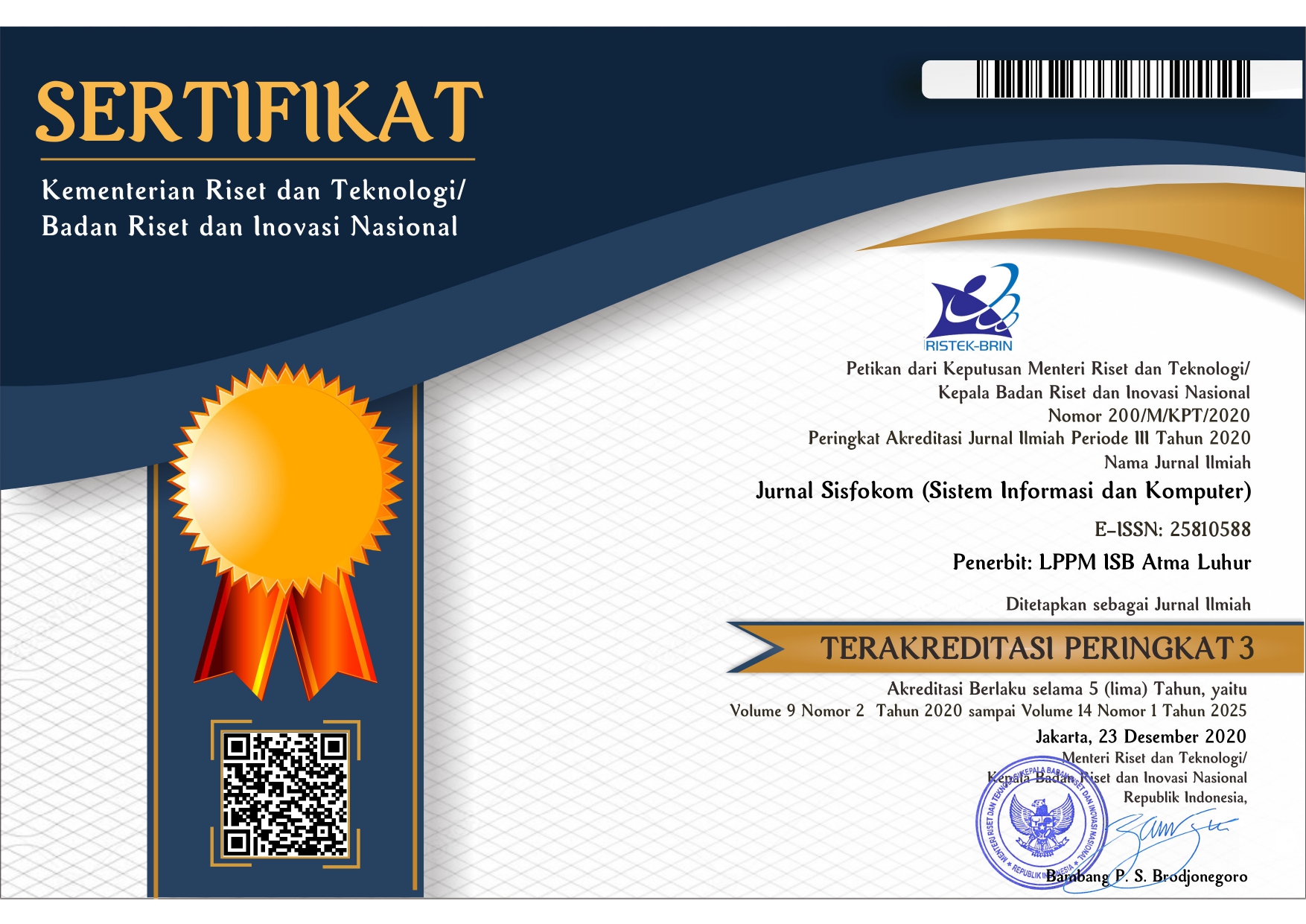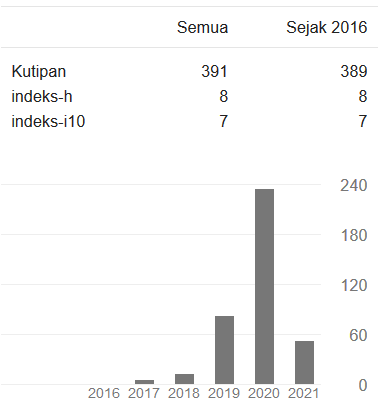The Development of Website on Management Information System for E-commerce and Services
DOI:
https://doi.org/10.32736/sisfokom.v9i3.992Keywords:
E-commerce, Management Information System, Service, Waterfall, WebsiteAbstract
Currently, the sales system is overgrowing. The concept of selling that was done manually (which is still less than optimal) becomes electronic (e-commerce). System development requires a digital platform. This platform must be able to carry out all activities that were carried out before (manually), such as collecting documents, recording transactions, and reporting. Besides, the e-commerce platform can provide support and increased performance in the sales process, both in checking stock items, transaction reports, and services. Besides, this optimization can provide services precisely and quickly to consumers. A management information system concept is needed to carry out e-commerce and services with integrated data and be stored in its development database. This prototype concept requires a method for website development. The method used is a waterfall. Website design uses the Hypertext PreProcessor (PHP) programming language and MySQL database. The design model uses two concepts: entity-relationship diagrams (ERD) and data flow diagrams (DFD). The result is a website and e-commerce services that can be accepted by users and e-commerce organizers with tests that have been carried out. System testing uses Blackbox and Whitebox testing, each of which results can be used to implement e-commerce sites and services. The website can assist officers in service and e-commerce and make it easier for officers to determine the target and service status.References
W. Reinartz, N. Wiegand, and M. Imschloss, “The impact of digital transformation on the retailing value chain,” Int. J. Res. Mark., vol. 36, no. 3, pp. 350–366, Sep. 2019, doi: 10.1016/j.ijresmar.2018.12.002.
V. Wohlgemuth, E. S. C. Berger, and M. Wenzel, “More than just financial performance: Trusting investors in social trading,” J. Bus. Res., vol. 69, no. 11, pp. 4970–4974, Nov. 2016, doi: 10.1016/j.jbusres.2016.04.061.
S. Cho, C. Park, and J. Kim, “Leveraging Consumption Intention with Identity Information on Sharing Economy Platforms,” J. Comput. Inf. Syst., vol. 59, no. 2, pp. 178–187, Mar. 2019, doi: 10.1080/08874417.2017.1326295.
B. Werse et al., “Sharing, Group-Buying, Social Supply, Offline and Online Dealers: how Users in a Sample from Six European Countries Procure New Psychoactive Substances (NPS),” Int. J. Ment. Health Addict., vol. 17, no. 5, pp. 1237–1251, Oct. 2019, doi: 10.1007/s11469-018-0043-1.
J. Kwak, Y. Zhang, and J. Yu, “Legitimacy building and e-commerce platform development in China: The experience of Alibaba,” Technol. Forecast. Soc. Change, vol. 139, pp. 115–124, Feb. 2019, doi: 10.1016/j.techfore.2018.06.038.
W. Liu, J. Zhang, S. Wei, and D. Wang, “Factors influencing organisational efficiency in a smart-logistics ecological chain under e-commerce platform leadership,” Int. J. Logist. Res. Appl., pp. 1–28, Apr. 2020, doi: 10.1080/13675567.2020.1758643.
L. Scarcella, “E-commerce and effective VAT/GST enforcement: Can online platforms play a valuable role?,” Comput. Law Secur. Rev., vol. 36, p. 105371, Apr. 2020, doi: 10.1016/j.clsr.2019.105371.
F. Aulkemeier, M. A. Paramartha, M.-E. Iacob, and J. van Hillegersberg, “A pluggable service platform architecture for e-commerce,” Inf. Syst. E-bus. Manag., vol. 14, no. 3, pp. 469–489, Aug. 2016, doi: 10.1007/s10257-015-0291-6.
K. C. Laudon and C. G. Traver, E-commerce: business, technology, society. 2016.
H. Aggarwal and S. Jain, “E-Commerce in India,” E-Commerce India Econ. Leg. Perspect., p. 36, 2020.
Y. Cui, J. Mou, J. Cohen, and Y. Liu, “Understanding information system success model and valence framework in sellers’ acceptance of cross-border e-commerce: a sequential multi-method approach,” Electron. Commer. Res., vol. 19, no. 4, pp. 885–914, Dec. 2019, doi: 10.1007/s10660-019-09331-0.
H. Wang, “The Balanced Scorecard Study on the Corporate Social Responsibility of Electronic Commerce,” in Modern Organisational Governance, vol. 12, Emerald Publishing Limited, 2017, pp. 161–185.
A. V. Barenji, W. M. Wang, Z. Li, and D. A. Guerra-Zubiaga, “Intelligent E-commerce logistics platform using hybrid agent based approach,” Transp. Res. Part E Logist. Transp. Rev., vol. 126, pp. 15–31, Jun. 2019, doi: 10.1016/j.tre.2019.04.002.
Y. Wang, Z. Yu, and M. Jin, “E-commerce supply chains under capital constraints,” Electron. Commer. Res. Appl., vol. 35, p. 100851, May 2019, doi: 10.1016/j.elerap.2019.100851.
N. Rao Kowtha and T. Whai Ip Choon, “Determinants of website development: a study of electronic commerce in Singapore,” Inf. Manag., vol. 39, no. 3, pp. 227–242, Dec. 2001, doi: 10.1016/S0378-7206(01)00092-1.
V. M. Sudhana, “Sistem Informasi Servis Dan Penjualan Sparepart Komputer Pada Toko Multinet Computer,” Kediri, 2017.
M. Burrohman, “Membangun Sistem Jual Beli Dan Servis Laptop Berbasis Client Server (Studi Kasus Toko Salamah Komputer Komplek Ruko Rame Mall Yogyakarta),” Yogyakarta, Indonesia, 2018.
Hendra, “Sistem Informasi Manajemen Penjualan Dan Servis Komputer Pada CV. Justin Komputer,” Palembang, Indonesia, 2016.
Sunardi, A. Fadlil, F. Al-anshori, and S. Saifullah, “Information System Development Based-on ERP and RAD Methods: Application for Activities Information Broadcasting,” JUITA J. Inform., vol. 8, no. 2, 2020.
E. Alomari et al., “Analyzing, Designing and Implementing a Consulting Company for Management Information Systems,” ALOMARI, E., ALSHAMMRY, M., ALHAMIL, S., ALSMADI, MK, ALSHABANAH, M., ALRAJHI, D., ALMARASHDEH, I. ELJAWAD, L, pp. 422–432, 2019.
A. V. Usman and F. N. Ogwueleka, “SDLC Models as Tools in the Development of MIS: A Study,” IUP J. Inf. Technol., vol. 14, no. 4, pp. 52–59, 2018.
K. Chari and M. Agrawal, “Impact of incorrect and new requirements on waterfall software project outcomes,” Empir. Softw. Eng., vol. 23, no. 1, pp. 165–185, Feb. 2018, doi: 10.1007/s10664-017-9506-4.
J. S. Valacich, J. F. George, and J. A. Hoffer, Esentials of Systems Analisis & Desain, 5th ed. E-Books: Prentice Hall Upper Saddle River, NJ, 2012.
S. Saifullah and A. Hermawan, “Sistem Penjadwalan Kuliah Berbasis Click and Drag (Studi Kasus di Fakultas Sains & Teknologi Universitas Teknologi Yogyakarta),” J. Tek. Inform. dan Sist. Inf., vol. 3, no. 1, pp. 31–45, 2017, doi: https://doi.org/10.28932/jutisi.v3i1.652.
S. Saifullah and A. Hermawan, “Pengembangan Sistem Penjadwalan Kuliah Menggunakan Algoritma Steepest Ascent Hill Climbing,” J. Sist. Komput., vol. 6, no. 2, pp. 57–62, 2016.
A. Silberschatz, H. F. Korth, and S. Sudarshan, Database System Concepts, 6th ed. (alk. paper) E-book, 2011.
Downloads
Additional Files
Published
Issue
Section
License
The copyright of the article that accepted for publication shall be assigned to Jurnal Sisfokom (Sistem Informasi dan Komputer) and LPPM ISB Atma Luhur as the publisher of the journal. Copyright includes the right to reproduce and deliver the article in all form and media, including reprints, photographs, microfilms, and any other similar reproductions, as well as translations.
Jurnal Sisfokom (Sistem Informasi dan Komputer), LPPM ISB Atma Luhur, and the Editors make every effort to ensure that no wrong or misleading data, opinions or statements be published in the journal. In any way, the contents of the articles and advertisements published in Jurnal Sisfokom (Sistem Informasi dan Komputer) are the sole and exclusive responsibility of their respective authors.
Jurnal Sisfokom (Sistem Informasi dan Komputer) has full publishing rights to the published articles. Authors are allowed to distribute articles that have been published by sharing the link or DOI of the article. Authors are allowed to use their articles for legal purposes deemed necessary without the written permission of the journal with the initial publication notification from the Jurnal Sisfokom (Sistem Informasi dan Komputer).
The Copyright Transfer Form can be downloaded [Copyright Transfer Form Jurnal Sisfokom (Sistem Informasi dan Komputer).
This agreement is to be signed by at least one of the authors who have obtained the assent of the co-author(s). After submission of this agreement signed by the corresponding author, changes of authorship or in the order of the authors listed will not be accepted. The copyright form should be signed originally, and send it to the Editorial in the form of scanned document to sisfokom@atmaluhur.ac.id.








